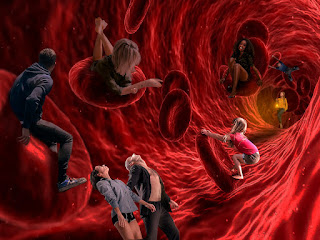Biology - Transportation in Humans
Introduction
The blood is responsible to transport food, oxygen, and waste materials in human bodies.
Blood usually consists of a fluid medium known as plasma where the cells remain suspended.
Plasma is responsible to transport food, carbon dioxide, and nitrogenous wastes in dissolved form.
However, oxygen is carried by the red blood cells.
Many other substances such as salts, are also transported by the blood.
A Human Heart
The heart is one of the most significant muscular organs of a human body.
As both the oxygen and the carbon dioxide get transported by the blood; so, to avoid the oxygen-rich blood from mixing with the blood containing carbon dioxide, the heart has different chambers.
Oxygen-rich blood from the lungs comes to the thin-walled upper chamber of the heart on the left, i.e. the left atrium (see the image given above).
When it is collecting the blood, the left atrium relaxes; however, while the next chamber, i.e. the left ventricle expands, then it (left atrium) contracts, so that the blood is transferred to it.
Further, when the muscular left ventricle contracts (in its turn), the blood is pumped out to the body. Likewise, de-oxygenated blood comes from the body to the upper chamber on the right, the right atrium (as it expands).
When the right atrium contracts, the corresponding lower chamber, the right ventricle, dilates and this act transfers blood to the right ventricle, which in turn pumps it to the lungs for oxygenation.
The ventricles have thicker muscular walls (than the atria do), as ventricles have to pump blood into various organs.
There are valves that ensure that the blood does not flow backwards when the atria or ventricles contract.
The separation of the right side and the left side of the heart is beneficial, as it avoids oxygenated and deoxygenated blood from mixing.
The animals, which do not use energy to maintain their body temperature, their body temperature depends on the temperature in the environment.
Such animals (e.g. amphibians or many reptiles), have three-chambered hearts, and bear some mixing of the oxygenated and de-oxygenated blood streams.
Fishes, on the other hand, have only two chambers to their hearts; however, the blood is pumped to the gills and get oxygenated there, and then passes directly to the rest of the body.
Blood Pressure
The force that blood exerts against the wall of a vessel is known as blood pressure.
The blood pressure is much greater in arteries than in veins.
During the ventricular systole (i.e. contraction), the pressure of blood inside the artery, is known as systolic pressure.
On the other hand, the pressure in artery during ventricular diastole (relaxation), is known as diastolic pressure.
The normal measurement of systolic pressure is about 120 mm of Hg and diastolic pressure is 80 mm of Hg. Increase of this pressure is known as high blood pressure or hypertension.
The instrument that measures the blood pressure is known as sphygmomanometer.
Lymph
Some amount of plasma, proteins, and blood cells escape (through the pores present in the walls of capillaries), into intercellular spaces in the tissues and form the tissue fluid known as lymph.
Though lymph is similar to the plasma of blood, but it is colorless and contains less protein.
An important function of lymph is to carry digested and absorbed fat from intestine and drains excess fluid from extra cellular space back into the blood.




Comments
Post a Comment